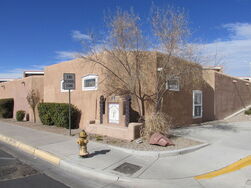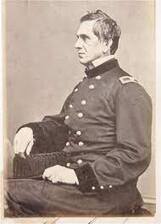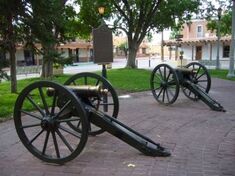 La Glorieta today. It was originally built sometime before 1803. John Phelan, CC BY-SA 3.0 La Glorieta today. It was originally built sometime before 1803. John Phelan, CC BY-SA 3.0 The Battle of Albuquerque was one of the least significant battles of the American Civil War. It was so small that it is more appropriately called a skirmish. General H.H. Sibley’s Army of New Mexico had begun with great intentions. Its leader had planned to take the California and Colorado goldfields at little cost to the Confederacy, fulfilling a Southern version of Manifest Destiny. But things went wrong from the start, and they soon discovered that New Mexicans were not as willing to feed and shelter an army made up of Texans as Sibley had supposed. After its supply train was destroyed while they were fighting the Battle of Glorieta Pass, Sibley’s army retreated to Santa Fe and began straggling into Albuquerque, where they commandeered La Glorieta, the already old hacienda that was owned by German entrepreneur Franz Huning.  Col. E.R.S. Canby Col. E.R.S. CanbyMeanwhile, Col. Canby, whose troops had been bottled up in Fort Craig and living on half rations, moved his men north, leaving Kit Carson and his New Mexico Volunteers to defend the fort. On April 8, Canby arrived at the small farming settlement of Barelas, south of Albuquerque. Scouting reports informed him that the main Rebel force had not yet arrived from Santa Fe and only a small group of Confederates held the town. Canby decided to use his four pieces of artillery to make what he called a “noisy demonstration.” Rebel cannons returned fire from Huning's grist mill, which was located near what is now the intersection of Laguna and Central. The artillery duel lasted for several hours until a delegation of concerned citizens approached Canby under a white flag. They explained that Sibley had refused to allow the town’s women and children to evacuate, and the Union shelling was endangering them. Rather than risk public opinion in a territory that wasn’t wholly supportive of American rule, Canby ordered his men to stop firing, ending the Battle of Albuquerque. The townspeople and the Confederates didn’t know it was over, however. They waited anxiously as the sunset glowed red, orange and pink. In the fading light, the yellow glow of Canyby’s campfires dotted the horizon. Union buglers, drummers and fifers played “Tattoo” marking the end of the day, then continued with more music as, gradually, the campfires died out. It wasn’t until morning that it became apparent that Canby and his troops had slipped away in the darkness, leaving the musicians and the campfires to cover their movement. Unwilling to face Sibley’s entire army, which might reach Albuquerque at any moment, Canby had moved his men eastward into the Sandia Mountains. A few days later in the little village of San Antonio, he met up with the Colorado volunteers now under the command of John Chivington. Now, he thought, his troops were large enough to resume the attack on Gen. Sibley.  The howitzer replicas, Old Town Albuquerque The howitzer replicas, Old Town AlbuquerqueBut Sibley’s forces had left Albuquerque, ending a possible second act of the Battle of Albuquerque. The General had arrived in Albuquerque soon after the artillery exchange and explained to his officers that, with only enough food for 15 days and no more than 40 rounds of ammunition per man, the best course of action would be to retreat down the Rio Grande valley and return to Texas. So that they couldn’t be used against his retreating troops, he had eight brass howitzers buried in a corral behind San Felipe Neri Church. On the morning of April 12, Sibley abandoned his wounded and proceeded south. The two armies would not encounter each other until two days later, at the Battle of Peralta. Although hardly a battle, the artillery duel is the only battle ever to be fought within the city limits of Albuquerque. The eight brass howitzers were later recovered, and two are preserved in The Albuquerque Museum and replicas of the guns stand around the edges of Albuquerque's Old Town Plaza..  Jennifer Bohnhoff taught New Mexico history at Desert Ridge and Edgewood Middle Schools, in central New Mexico. She is now a full time author and lecturer. Rebels Along the Rio Grande is her trilogy of historical fiction set in New Mexico, and is suitable for middle grade through adult readers. Where Duty Calls and The Worst Enemy are already published. The third and final book in the trilogy, The Famished Country, will be released in October. The Battle of Albuquerque will be depicted in that book. |





No comments:
Post a Comment